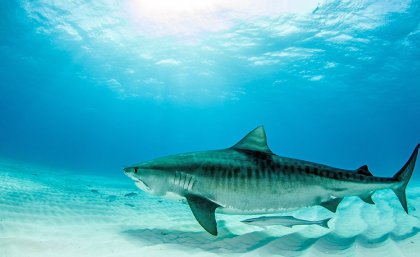
Tiger sharks roam huge distances across the Indo-Pacific, contributing to a single, large population, a study has found.
The University of Queensland’s Dr Bonnie Holmes said sampling from tiger sharks (G. cuvier) at seven locations across the region revealed little genetic differentiation from the Pacific to the Indian Ocean.
“We analysed samples from the Indian Ocean off Western Australia, in multiple locations in the Western Pacific and as far away as Hawaii in the Central Pacific.”
“The gene pool was much the same for all tiger sharks in the Indo-Pacific region, countering previous research suggesting a distinct Hawaiian population structure,” Dr Holmes said.
She said the study highlighted the need for cross-jurisdictional efforts to manage the sustainable fishing of large migratory sharks.
“In Australia these sharks have a higher level of protection than when they move into international waters, where they are often targeted for their large fins.
“There needs to be cooperation between international authorities to ensure that there are adequate no-take zones within our oceans.”
She said the tiger shark’s wide-ranging migratory behaviour may be advantageous for populations that are heavily exploited, aiding in maintaining the genetic diversity of the broad-scale population.
“For instance, there is evidence of migrating sharks from both the east and west coasts of Australia moving into Northern Territorial waters,” Dr Holmes said.
“Our research also shows the relatively shallow waters between Cape York and Papua New Guinea do not act as a barrier to movement and gene flow as it does for some fish species.”
Dr Holmes said there was genetic differentiation when the Indo-Pacific samples were compared to a Brazilian sample from the western Atlantic.
Dr Holmes undertook her PhD on tiger shark biology and ecology with the School of Biological Sciences, and the Molecular Fisheries Laboratory at the School of Biomedical Sciences. The research is published in The Royal Society journal Open Science.
Dr Holmes said the lab was continuing to investigate migratory populations using a new method to extract DNA from the jaws of tiger and white sharks held in museums and trophy collections.
Media: Dr Bonnie Holmes, b.holmes@uq.edu.au, 0411 240 806; Kim Lyell, k.lyell@uq.edu.au, 0427 530 647.
.jpg)









